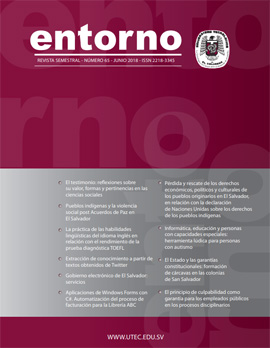Informatics, education and people with disabilities : a ludic tool for people with autism
Published 2018-06-01
Keywords
- Autismo – Investigaciones,
- Tecnología de la información,
- Innovaciones tecnológicas,
- Personas con discapacidades del desarrollo,
- Estudiantes con discapacidades
- Educación especial,
- Juegos educativos ...More
Copyright (c) 2018 Bladimir Díaz Campos

This work is licensed under a Creative Commons Attribution-NonCommercial-ShareAlike 4.0 International License.
How to Cite
Abstract
The use of technology in different areas of our everyday life is becoming essential since these tools help us to perform our activities in a better way, and education is one of the areas which requires a considerable investment of time.
Education is a hard task in itself since each one of us learns in different ways. Then, when the one to be taught has a special attention capacity over what he or she performs, as is the case of autism or any other that requires special attention, this task becomes more complicated.
The objective of this article is to show the design of a prototype for a ludic tool that allows students (in this case, students with autism), to improve the teaching learning process.
URI: http://hdl.handle.net/11298/452
DOI: https://doi.org/10.5377/entorno.v0i65.6049
References
- Autism Speaks. (2014). ¿Qué es el autismo? una descripción. Recuperado de https://www.autismspeaks.org/qu%C3%A9-es-el-autismo
- Casanova M. (2014). El aprendizaje y el autismo. Recuperado de https://autismodiario.org/2014/06/29/el-aprendizaje-y-el-autismo/
- Gómez Villa, M., Franco Morales, A. M., Martínez Valenzuela, J., Pastor Marín, P., Marín Saorín, S., Reyes Camacho, A., & Villalba del Baño, J. (2002). Herramientas de autor y aplicaciones informáticas para alumnos con necesidades educativas especiales asociadas a grave discapacidad. Recuperado de http://servicios.educarm.es/templates/portal/images/ficheros/revista Educarm/6/e2k05_06.pdf
- Haugland, S. W., & Sade, D. D. (1994). Software evaluation for young children. En J.L. Wright y D.D. Shade (Ed.), Young children: active learner: in a technological age. Washington: Naeyc.
- Koon R. A. (2017) El impacto tecnológico en las personas con discapacidad. Recuperado de http://www.repositoriocdpd.net:8080/bitstream/handle/123456789/363/Pon_KoonRA__ImpactoTecnologicoPersonas_ 2000.pdf?sequence=1
- Naciones Unidas. (2015). Piramide de población del mundo. Recuperado de https://populationpyramind.net/es/mundo/2015
- Navarro, E. (1999). Evaluación de materiales multimedia. Comunicación y pedagogía. 157, 36-3
- OMS. (2011). Programas y proyectos. Recuperado de http://www.who.int/dg/speeches/2011/disability_20110609/es/
- Sánchez Asín, A., Boix Peinado, J. L., & Jurado de los Santos, P. (2009). La sociedad del conocimiento y las Tics: una inmejorable oportunidad para el cambio docente. Pixel-Bit. Revista de medios y educación. Recuperado de http://www.redalyc.org/articulo.oa?id=36812036013
